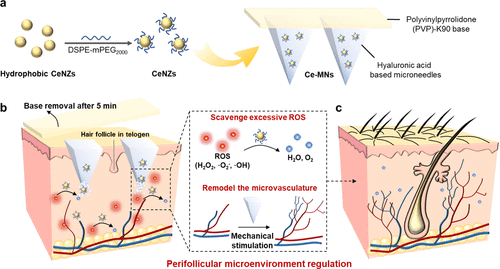ZJU scientists deliver nanozymes into epidermis with dissolvable microneedles for rapid hair regeneration
2021-10-09 |
Hair loss is becoming an increasingly common problem. Over 50% of the general population experience hair loss at some point in their lifetime and it does impact the body images, social interactions, and psycho-emotional health of individuals. Don’t worry. The good news is coming. Recently, the research team led by GAO Jianqing and LI Fangyuan at the Zhejiang University College of Pharmaceutical Sciences designed a ceria nanozyme (CeNZ)-integrated microneedles patch (Ce-MNs) that can alleviate oxidative stress and promote angiogenesis simultaneously to reshape the perifollicular microenvironment for androgenetic alopecia (AGA) treatment. The research findings are published in ACS Nano.
The most common form of hair loss is AGA, a chronic and progressive disease. Although several clinical drugs have been used for AGA treatment, they have not yet produced satisfactory results. In addition, there are also reports about their side effects.
The leading cause of AGA is the dysregulation of the hair follicle (HF) niche, which is generally induced by vascular insufficiency or oxidative stress in the perifollicular microenvironment.
Inadequate vascularization in the balding region of AGA patients results in insufficient delivery of nutrients and other bioactive molecules to HFs, thereby constraining the transition of HFs from telogen to anagen.
In addition to inadequate vascularization, oxidative stress overrides innate antioxidant defense mechanisms and thus provokes cellular apoptosis in HFs. Moreover, excessive reactive oxygen species (ROS) can trigger the premature senescence of dermal papilla cells and subsequently suppress the telogen-to-anagen conversion of HFs through the mediation of androgen signaling and activation signaling.
Ce-MNs are featured by their remarkable mechanical strength. They can be efficiently delivered into the skin. This safe Ce-MNs patch can reshape the oxidative microenvironment around HFs, thus providing a promising strategy for AGA treatment.
Ce-MNs can deliver the loaded CeNZs into the dermis and epidermis directly to scavenge excessive ROS with catalase and superoxide-mimic activities. Meanwhile, the mechanical stimulation induced by the administration of MNs is capable of remodeling the microvasculature in the skin, thereby benefiting the induction of the anagen phase of HFs. The Ce-MNs system can thus promote hair regeneration.
“This kind of CeNZ is marked by strong enzyme-mimic activity and it can scavenge a variety of ROS, including superoxide anions, hydroxyl radicals and hydrogen peroxide, therefore improving the HF microenvironment. From our tests on cells as well as animals on a whole, the use of CeNZ can significantly promote HF activation with little damage to skin cells or HF cells,” Gao said, adding that there’s still a long way to go from bench to bedside, whether it be policy, large-scale preparation technology or curative effect for large animals.
“Nanozymes with dual identities of nanomaterials and enzymes have very unique advantages,” Li said.“We have been committed to the controllable synthesis and medical applications of nanozymes. In addition to this study, we have already verified its excellent therapeutic effect on drug-induced liver injury, diabetic wound healing, and so on. We hope to continue to make new breakthroughs in the field of nanozymes.”








